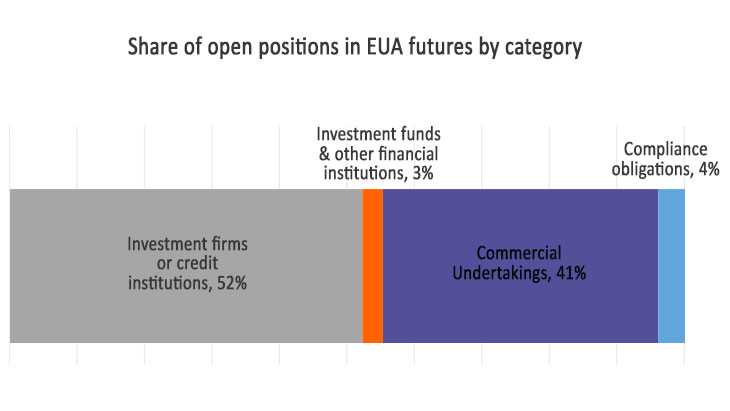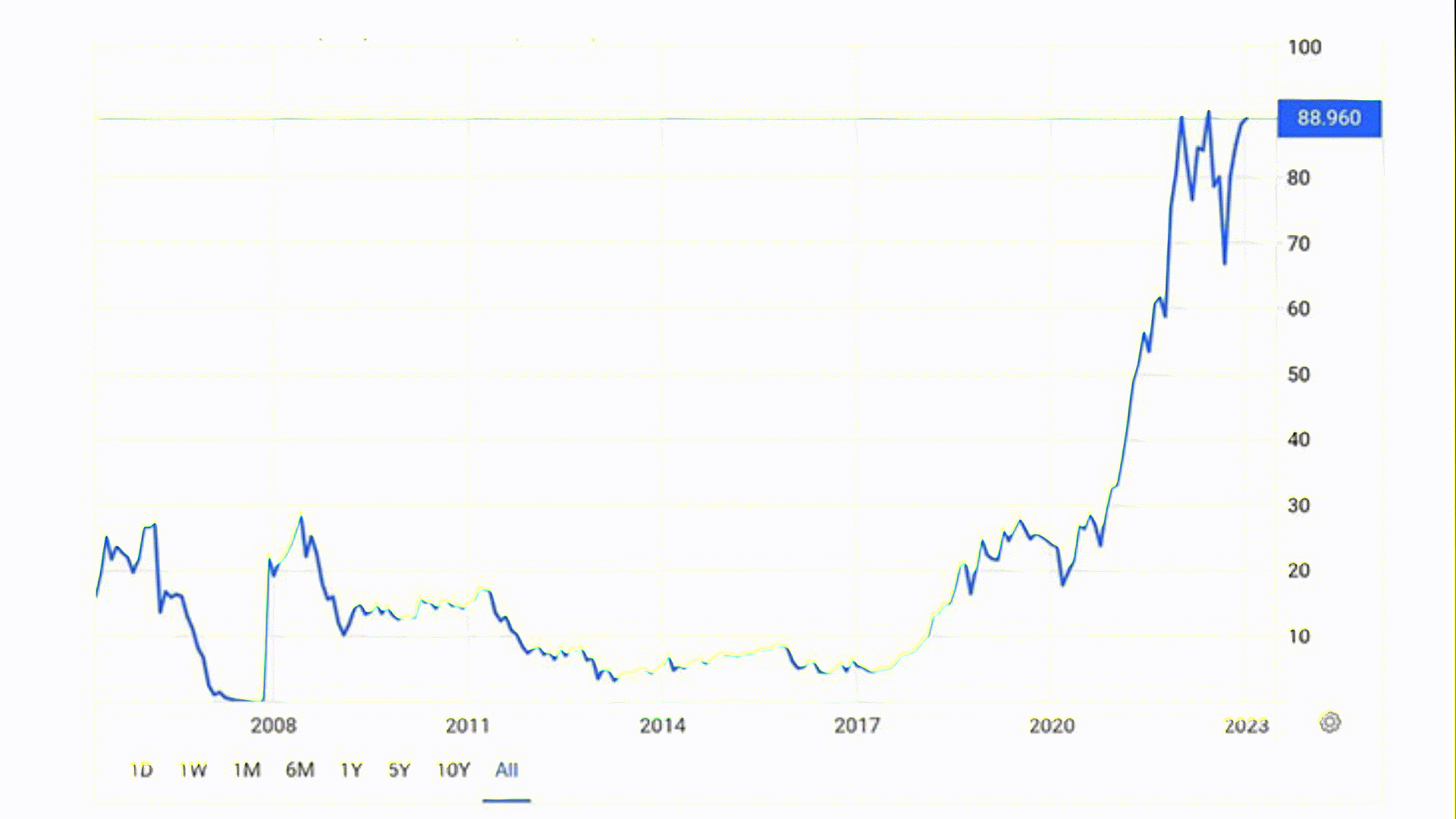To start our discussion, please take a look at this historic curve:
Whatever commodity this would be, something strange is going on: the price collapsed to zero in late 2007, then as from the second quarter of 2021 it is going up and up to reach euro 90 in January 2022, just before the awful war. Currently, this commodity is trading in the 90 to 70 range.
What is this mysterious product that was free of charge sixteen years ago and is around euro 82 today?
The answer: this is the historic price curve of the EU Allowance market, commonly referred to as “CO2 certificates”. If we believe that global warming is important, if we want to pass on a cleaner Earth to our children, then we should stop here for a moment to reflect on whether the European CO2 market is actually doing what it was supposed to do: i.e. making sure that global warming is reduced and our children will live on a greener planet. As the above historic curve shows, the European emission market (to use yet another name for the same product) failed. This short writing will summarize what happened.
The original idea was brilliant and it followed from the 1997 Kyoto protocol: if you are a power station, or fertilizer plant, etc. and you are emitting (to use the official word) industrial gases into the air, you must have enough EU Allowances on your account by 30 April of each year to cover every tone of CO2 emitted in the previous calendar year; otherwise, you have to pay a penalty of euro 100/ton (originally, euro 40 only). So began the biggest carbon market (worth roughly euro 700bn) on Earth in 2005.
How did the EU manage to mess up this otherwise simple idea?
The first problem was oversupply. As a main rule, the EU is emitting around 1.5 bn tones of CO2 per annum from installations that are subject to the EU Emission Trading rules, yet during the first compliance period (the last eighteen years between 2005 and today are divided into sub-periods with changing rules and regulation) roughly 1.7 bn tones of EU Allowances were in circulation. Of course, the price of CO2 certificates collapsed to zero before the end of the first compliance period in 2007. Hundreds of traders earned millions of euros on “selling short” the carbon market – i.e. they sold EU Allowances they did NOT have on their accounts, as soon as they realized that the market was badly oversupplied. Also some utilities, notably a Czech multi-utility, followed the same strategy. As per some annual reports from 2006 and 2007, the biggest single source of profit for such state-owned utilities was the fast selling of EU Allowances that they had received free of charge. Traders, speculators and utilities made an unimaginable amount of money from this market-design fault (i.e. too many certificates in circulation).
The EU faced a hard choice in 2007: either reform the carbon market or let it collapse. This horror arrangement was socially not useful and only made the rich (traders and manipulators) richer, while the Earth was not getting greener. So many reform steps followed that it would take pages just to list them. Here, I am highlighting only the most important ones for us. First of all, the idea of auctioning EU Allowances (as opposed to free allocation) was introduced, although originally for 10% of the market only. Then came the so-called “back-loading” – this was about reducing the number of EU Allowances auctioned by 900 million in total during 2014-2016. Then followed the setting up of the so-called “Market Stability Reserve (MSR)”. This is a complex name for a simple idea – to avoid the repeat of a 2007 disaster (over-supplied market), the EU can off-take CO2 certificates from the market, via this mechanism, if too many EU allowances were in circulation, and vice versa. For the MSR to function correctly, it was essential that the number of CO2 certificates in circulation to be officially published each year: this was the input information to decide whether extra certificates will be released to the market or withdrawn. Finally, the last legacy of the Kyoto protocol – the so-called Joint Implementation (JI) and Clean Development Mechanism (CDM) was discontinued in Europe. Behind this confusing dictionary, fraudulent and misleading projects were hiding: never-existing developments received JI and CDM credits that could be sold in Europe on the carbon market. Here again hundreds of “developers” took extra profit, while nothing whatsoever happened to global warming and no real steps were taken to reduce global warming. The EU made the correct decision when JI and CDM credits were barred from Europe.
Then came the post-Covid period with “NextGenerationEU”, “MFF” [multiannual financial framework], and other by-words to cover up the fact that the EU was ready to release never-seen amount of money (roughly two trillion euros) to kick-start the European economy. The US government was doing the same (roughly two trillion US dollars), but used different “code names” – Coronavirus Aid, Relief, and Economic Security Act (CARES Act). Now all the ingredients were ready to turn the European CO2 industry into a real global financial market. On the one hand, the EU carbon market was (is) the biggest on Earth, it was (is) trading through exchanges, the total number of EU Allowance in circulation was (is) published each year and it was (is) a “politically correct” instrument (green Earth, fighting global warming, etc.). On the other hand, there were the banks and other financial institutions in 2021 not sure where to invest that extra post-Covid money: property prices were up, shares were over-priced and gold was expensive. This was the moment when the US and European banks discovered the EU Allowance market.
First, they could not believe their luck: here was a financial (no physical delivery) instrument that is trading via exchanges (no counterparty risk), where the number of traded units (EU Allowance) is strictly controlled (i.e. limited supply-side) and the number is annually confirmed. Compare this arrangement to oil or coal: here you have to take delivery and store your oil, you are directly dealing with producers and traders, you never know how many millions of barrels will be around next year; while coal has the same problems, it is also politically unacceptable to banks.
But for the banks and other financial institutions to enter the European carbon market some extra regulatory reforms were necessary. Perhaps it was only a matter of luck, but the new (latest) compliance period for the EU Allowance market was due to start exactly in 2021 (i.e. when the post-Covid money was sitting on the books of the US and EU banks looking for a suitable market). And this was the moment when the joint US-EU banking sector teams “reformed” (rather: took over) the EU allowance market. The most important “regulatory changes” may be summarized as follows:
- Annual automatic emission cut (the number of EU Allowances canceled) increased to 2.2%;
- The amount of EU Allowances put into the above-mentioned Market Stability Reserve (i.e. taken off the market) doubled to 24%;
- Further restricting the free allocation under the code name of “carbon leakage”; and
- Two new funds (Innovation Fund and Modernization Fund) were established (to be managed by banks).
Against this background, it is no surprise that the price of CO2 certificates almost tripled in value in 2021. Just remember the first chart above: this price jump is clearly visible, it is like a shooting arrow up to euro 90/ton. Banks started to buy up EU Allowances: it was a “politically correct” investment into an exchange-traded commodity that is in short (and limited) supply. As of today, banks and financial institutions hold more CO2 certificates on their books, than the actual power stations, fertilizers, and other producers (called: emitters). What kind of absurd market is this, where the ones who have the compliance obligation (emitters) have fewer EU Allowances, than financial investors and speculators?

Source: ING Bank (https://think.ing.com/articles/eu-carbon-market-update-compliance-deadline-sees-market-move-higher)
But who pays for this show? How is this huge CO2 price increase financed? The sad answer is that everybody who is using electricity, including you and me. For the power sector, EU Allowances are an input price, like gas or oil or coal. As and when the price of CO2 increases, power generators have no choice, but to increase the price of electricity sold. This is exactly what happened as from the second quarter of 2021, when banks entered the European carbon market en masse.

Source: Hudex
The final (disturbing) conclusion from the above analysis is that every single electricity user (from big industry to the last pensioner) pays more for electricity to cover the extra profit certain banks and financial institutions are making in the European carbon market. At the same time, global warming was further increasing in 2022 (extra 0.89 C). Referring back to the starting points of this writing, if we really wish to do something against global warming, if we want to pass on a greener Earth to our children, we should start thinking about a new way to trade CO2 in Europe, and also around the world: this current system seems to be dysfunctional, but expensive. We can do better, if we try together to come up with new ideas.
About the autor Jozsef Balogh is a senior business developer for Axpo Solutions, Switzerland, with a special focus on Central European and Ukrainian electricity, gas and CO2 opportunities. He had been active in the Central European energy industry in various roles since 1992. He has been especially active in Ukraine and Hungary.

